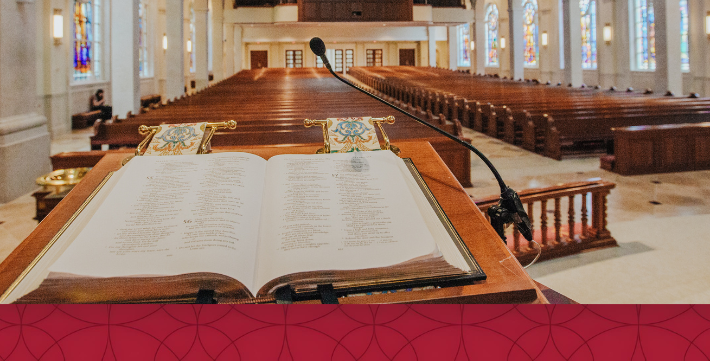Commentary on Luke 3:1-6
On the second Sunday of Advent, John the Baptizer gets a little limelight.
By this point in Luke’s Gospel, readers already know a great deal about John: he will be a prophet, filled with the Holy Spirit, “great in the sight of the Lord,” and someone who prepares for the Lord by a message of repentance, salvation, and forgiveness (1:15–17, 76–77). Luke associates John with the “messenger” of Malachi 3:1–4, the first reading for Advent 2 (Luke 1:76; 7:27). Since John’s birth, “the hand of the Lord was with him” (1:66). And from early on, he has remained in the wilderness (1:80). So, as John begins his public ministry in Luke 3, much is already known and expected.
Luke 1–2 focuses on the early years of both John and Jesus in parallel fashion. The shift in chapter 3 to John’s public ministry as an adult, then, only suggests a focus on Jesus’ public ministry is very soon to come.
The significance of history
Luke begins 3:1–6 with the voice of a historian. He has done this before (1:5; 2:1–2). But this list of rulers is much longer. It contextualizes the ensuing story of John and Jesus within the geopolitical landscape of the early first century.
Luke 3:1–2 identifies the most prominent rulers of Galilee and Judea at this time (circa 28–29 CE). Tiberius ruled as emperor in 14–37 CE. While Tiberius was never associated with persecuting Christians, many in Luke’s day thought him cruel, perverse, and self-indulgent.1 His rule was a stark contrast to the kingdom Jesus proclaimed. Pontius Pilate was governor of the Roman province of Judea in 26/27–36/37 CE. His role put him in charge of Jesus’ trial and death.
Herod Antipas was the son of Herod the Great, tetrarch of Galilee and Perea, and the “Herod” who engages Jesus most in the Gospels. Only Luke includes Herod Antipas in Jesus’ trial (23:6–12).
Annas was high priest in 6–15 CE (until deposed) and his son-in-law Caiaphas, in 18–36/37 CE. Although Caiaphas was high priest at this time, Annas’s presence still loomed large.
This historical grounding resonates with a larger theme in Luke-Acts: salvation history. That is, God brings about salvation not in the abstract or in theory, but through concrete events, real people, in actual places of history—with Jesus’ life, death, resurrection, and ascension being the quintessential example. God saves not in Neverland or “somewhere over the rainbow,” but in history. Corrupt, messy, and complicated as historical events and situations are, that is where God saves.
A prophetic messenger of salvation
Luke portrays John as a prophet, using language from the Old Testament prophets: “The word of God came to …” (Isaiah 38:4; Jeremiah 1:1–4, 11; Hosea 1:1). Josephus reports there were many leaders at this time who gathered people in wilderness areas, mostly for militaristic causes.2 But John’s ministry of social renewal and transformation was not militant—and his legacy was more historically enduring.3
John’s ministry takes place in the wilderness (erēmos) at the Jordan River. Both places were heavily associated with the exodus story of freedom from slavery, wilderness wanderings, and crossing the Jordan to the promised land. His baptism resonates with Jewish water rituals associated with cleansing (Leviticus 14–15; Zechariah 13:1) as well as initiation rites used at Qumran.4 In Luke 3 it is a “baptism of repentance,” clearly associated with demonstrative life changes to align with God’s purpose.
That John’s message is summarized by Isaiah 40:3–5 (Luke 3:4–6) is no coincidence. It taps into traditional hopes for Israel’s restoration among the nations, implying a new restoration for God’s people. The phrase “all flesh shall see the salvation of God” (verse 6) uses distinctive wording (to sōtērion tou theou) that appears only in Luke 3:6 and Acts 28:28 (“this salvation of God has been sent to the Gentiles/nations”), creating a bookend structure around Luke-Acts.
For today: Contrasting allegiances
Luke’s list of rulers not only anchors his story in history—it also sets up a contrast between their rule and the way of Jesus. To varying degrees, these leaders represented power, influence, and widespread practices of dominance and avarice. Much in contrast is John: a strangely clothed prophet who arises from the wilderness, abrasively calling people to divest their resources and act justly, redirecting their allegiance to a “Lord” utterly different from those in power. John’s ministry exemplifies the stark contrast that Jesus’ life, message, and ministry will have with the powers of their day.
We are invited to imagine the cultural norms and objects of devotion from which John would call us to repent today: overconsumption, materialistic accumulation, indifference to inequities, ungenerosity, superficial spirituality, arrogant judgmentalism, and characterizing our neighbors in the worst possible light. Where would John’s prophetic critiques focus today? The practices in which we engage are ultimately acts of allegiance to cultural and ethical norms, however unspiritual they may appear. John had the gall to call such things out.
For today: Redirection to God
John’s message was not to repent for repentance’s sake. He redirected hearers to God—with the promise of salvation (the forgiveness of sins). John’s message was not purely negative: he called people to recalculate their lives, turning intentionally to a lasting source of life and reconciliation.
As a word of promise, John’s ministry points beyond itself to a better object of devotion: Jesus. John’s message redirects our focus to a salvation from God that is truly good news for all people: “To you is born this day … a Savior, who is Christ the Lord” (2:11).
John’s message calls hearers in his day and ours to prepare for Jesus’ arrival, not by frantic busyness and materialistic generosity, but by a recalculation of our course and an openness to a Savior who comes among us still.



December 8, 2024